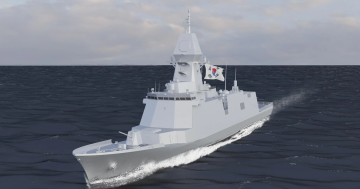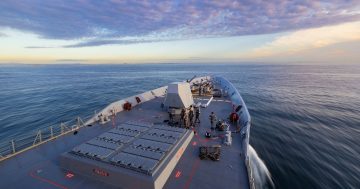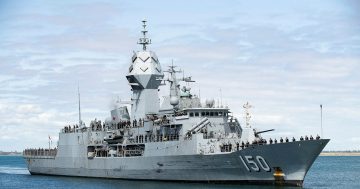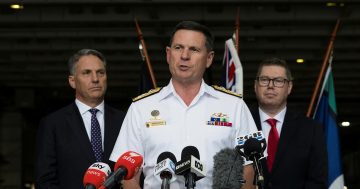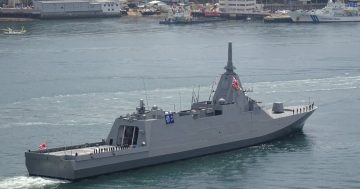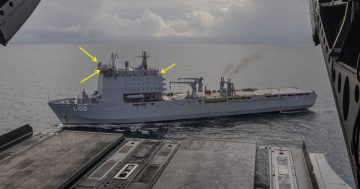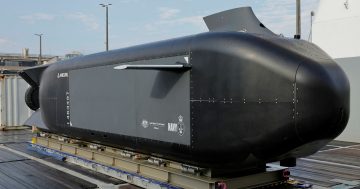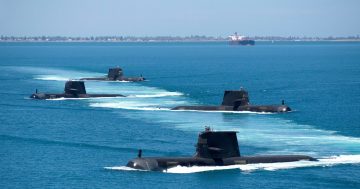
The upgraded Mogami is significantly larger and has much greater firepower than the Anzac-class vessel it will replace but requires fewer sailors. Photo: ADF.
The Federal Government has announced that a Japanese design has been selected to fulfil the requirements of the Royal Australian Navy’s (RAN’s) new general purpose frigate (GPF).
The government says 11 MHI upgraded Mogami-class GPFs will be acquired, the first three of which will be built in Japan by Mitsubishi before production of the remaining eight vessels switches to a new dedicated facility operated by Austal at the Henderson Defence Precinct south of Fremantle.
The Project SEA 3000 GPF requirement came out of the government’s Surface Fleet Review, released in early 2024, which saw the number of the large Tier-1 Hunter-class frigates cut from a planned nine to six, and the planned fleet of smaller Tier-3 Arafura-class offshore patrol vessels (OPV) reduced from 12 to six and the OPVs’ mission relegated to a constabulary role.
To bolster these gaps in the future fleet and to replace the ageing Anzac-class frigates, which entered service in the 1990s and early 2000s, the government instead proposed a rapid procurement of Tier-2 combatants in the form of the GPF.
The announcement of the winning design comes about four months ahead of the schedule the government had originally planned, perhaps reflecting the current global geostrategic situation as well as a need to retire the remaining Anzac-class frigates sooner rather than later. It also comes after a Japanese delegation reportedly conducted its final briefings on its GPF proposal to Australian defence officials in late July.
The upgraded Mogami-class frigate is built by Mitsubishi Heavy Industries (MHI) and is an evolution of 12 such vessels in service or being built for the Japanese Self-Defence Force (JSDF).
The upgraded Mogami was selected ahead of the MEKO A-200 design submitted by Germany’s Thyssenkrupp Marine Systems (TKMS). Defence Minister Richard Marles said the National Security Committee of Cabinet (NSC) selected the Mogami because it was the better ship of the two, while Defence Industry Minister Pat Conroy added that the Mogami had won out on cost, price and schedule.
Mr Conroy also pointed out the advantage of Australia’s ships coming off an established production line with few changes required, despite the design selected by Australia being an upgraded variant of the Mogami that is longer than Japan’s 12 original ships.
The stealthy upgraded Mogami features 32 Mk41 vertical launch system (VLS) cells compared with 16 cells on the original Mogami design and just eight on the Anzac class, an improved radar, and an increase in length to 142 metres and in its full-load displacement to 6200 tonnes. Japan has stated it plans to acquire 12 upgraded Mogamis from 2027 to add to its 12 original Mogami-class frigates.
Mr Conroy said there would be no major changes to the upgraded Mogami design for Australia other than language translations in the combat management system, and any changes to safety systems required by Australian regulations. Therefore, the GPFs will have different sensors, combat systems, interfaces, and key sub-systems to those of the navy’s current Anzac and Hobart and future Hunter-class fleets.
Compared with the Anzac-class ships it will replace, the upgraded Mogami displaces 3000 more tonnes, has 50 per cent more range, and much greater firepower with torpedoes, surface-to-air missiles and anti-ship missiles. But with many automated systems requiring a crew complement of just 90, it will require 40 fewer sailors than an Anzac.
Contractual negotiations with Mitsubishi and the Japanese Government will soon get underway, after which a more detailed budget and schedule will become apparent. The first GPF is scheduled to be delivered to Australia in 2029 and commissioned for operational service in 2030.
Mr Marles said the announcement was an example of the government’s focus on investing in new capabilities to meet Australia’s strategic circumstances.
“The upgraded Mogami-class frigate will help secure our maritime trade routes and our northern approaches as part of a larger and more lethal naval surface combatant fleet,” he said.
“The Albanese Government is delivering these commitments at pace as part of our sustained commitment to continuous naval shipbuilding in the West – driving jobs, investment and infrastructure for decades to come.
“We thank both Mitsubishi Heavy Industries and Thyssenkrupp Marine Systems, as well as the governments of Japan and Germany, for their focus and cooperation throughout this procurement process.”
Mr Conroy said the stealthy Mogami frigates would reassure Australia’s allies and deter its adversaries.
“The upgraded Mogami‑class frigate is the best option for our navy, boosting its capability to put to sea,” he said.
“It will take our general purpose frigates from being able to fire 32 air-defence missiles to 128 missiles, giving our sailors the cutting‑edge weapons and combat systems they need to prevail in an increasingly complex environment.
“This decision comes months ahead of schedule, reinforcing our commitment to deliver capability at speed and at a lower overall cost to taxpayers.”
Original Article published by Andrew McLaughlin on PS News.












